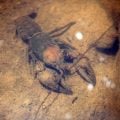How to Tie a Furled Chimarra Caddis Larva
Producer: Tim Flagler
Great flies needn’t be complicated. As simple as this Chimarra Caddis larva is, it checks all the boxes – size, profile, color and detail. In addition, it has caught a whole ton of trout for me over the last few years. Here in New Jersey, Chimarra Caddis begin hatching in February and continue to do so throughout much of March, so the larva are active and available at this time. Trout seem to show little interest in the black winged adults but have a hard time resisting the brightly colored larvae.
This furled imitation starts with a size 18 scud hook, like this Lightning Strike SE1. Begin by getting the hook firmly secured in the jaws of your tying vise.
For thread, I load a bobbin with a spool of UTC 70 Denier in rusty brown. The rusty brown color closely matches the color and translucency of the natural’s head. Get your thread started on the hook shank and take a few wraps rearward before snipping off the excess tag. Try not to go any further back than a hook-eye length or so.
DMC 6-strand embroidery floss is used for the body of the fly. It can be found nearly everywhere. The color I really like is #743 but any of the orangy-yellow shades will work just fine. Snip a 10” length free from the hank then separate it in two, to form two lengths, with three strands each. This is enough to make numerous flies. Snip off one end of one of the lengths, square and neat.
Give your bobbin a good counterclockwise spin, as if you’re looking down on it. This will cause your first wrap of tying thread to jump rearward and catch the end of the floss. Keep taking forward wraps to anchor the floss, all the way up to the hook eye. Resist the urge to take thread wraps too far down the hook shank.
Pull the floss down and twist it in a clockwise direction until it’s very corded up. Bring the floss up and place it on top of the hook shank. It should immediately twist, or furl, into a slender body, about a hook gap and a half in length. Pinch the material on top of the hook shank and start taking thread wraps to secure it. At the back edge of the hook eye, lift the material up and, using the eye as a guide for your scissors, snip the excess off close. Continue taking wraps of tying thread to cover up the end of the floss and create a slightly bulbous, little head on the fly. Pick up your whip finish tool and use it to do a 5 or 6 turn whip finish, then seat the knot well and snip or cut your tying thread free.
A drop of head cement, here Sally Hansen Hard as Nails, applied to the thread wraps, not only keeps them from unraveling, but also adds to the look of the fly. Just make sure the hook eye is clear of adhesive before allowing it to dry.
And that’s all there is to the Furled Chimarra Caddis Larva. Flies simply don’t get much easier. Tied in different colors, the pattern also does a remarkable job of imitating a variety of midge larva.
How to Tie a Fur Hackle Mayfly
How to Tie a Gartside Minnow











